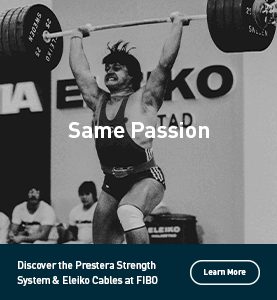features
Retention: What's in a name?
In the first part of a new series, Dr Paul Bedford takes a look at the impact of brand on member retention
What are the key factors that influence a member’s behaviour? In a new series for Health Club Management, we will explore the findings of a brand new retention study designed to offer insights into why members behave in certain ways (see p43 for more details).
This first feature will explore the attitudes, beliefs and factors influencing people’s decisions to join and remain at a health/fitness club in regards to brand.
Future articles in the series will focus on a broad range of factors that affect retention, such as how people select a health and fitness club in the first place, quality of the offering, perceived value for money and the importance of community – including social media and members’ sense of connectedness.
The importance of brand
The term ‘brand’ has been adopted to mean the features of a company’s products or services that differentiate it from another company’s products or services. The brand of a business
is an intangible asset that’s managed or controlled in a way that supports the ethos and the identity of the product or the service.
In the health and fitness sector, the most obvious demonstrations of brands are usually considered to be the multi-site operators, particularly from the private sector, but local authorities, trusts and other public sector operators also have a brand – and our research indicates that ‘brand’ plays a big part in members’ initial decision to choose one operator over another.
First-time exercisers
Brand was a key factor for all of those who were starting exercise for the first time. Location and cost remained the largest factors in the decision-making process, but beyond that brand was a key consideration when choosing which club to join.
Members surveyed described feeling more confident in a branded exercise chain, particularly in its ability to deliver the results they were looking for. Branded chains were also perceived as being socially acceptable places to exercise. Feedback included: “You can tell people at work you’ve joined X club and they don’t think that’s unusual or odd,” and: “I would think more of my employer if they had a corporate deal with a chain than a little club round the corner”.
Multi-site operators
Multi-site branded chains do not, however, fare well when members are looking for a second club to join. In our research, seven out of 10 new members surveyed said they had previously been members of another gym. In order to identify what operators can do to retain members, we began to explore why members left their previous club and how they chose their next club.
Those surveyed reported that, while on the surface the branded club appears to offer much, in practice it does little to differentiate itself from other operators. While members will leave one brand and join another, it’s not actually the brand that’s the deciding factor.
“I’ve been a member of five clubs now,” said one respondent. “At first, I went for one of the big brands that you see advertising in the papers and at the station. When I moved job, I had to look for another club and I noticed that, apart from the branding, what was on offer was very similar.” Another observed: “I thought, if they were that well-known, they must be good, but on reflection it wasn’t that different from the council gym down the road.”
These sentiments were common in our research. Members who left one club and joined another felt that, once they had something to compare them to, the branded chains were really no different from the independent clubs or public sector offering.
The independents
Those who are new to the health club experience are, it seems, attracted to the branded multi-site operators. However, when seeking a new club, brand becomes less important, with products (gym, classes, pool) and the experience being the factors seasoned gym-goers use to make their decision.
Independent operators that make effective use of branding – creating a strong USP – fare better in the long term than the multi-site operators. It appears that the ability of these operators to communicate a relevant message to prospects is what sets them apart. They are usually more niche, or at least with a bias in their offering – for example, even if they offer both gym and studio, their focus will be more heavily on one than the other – and that’s reflected in the branding, as well as the service and products delivered.
“I joined here because there’s a strong class programme,” said one respondent. “The quality of the teaching is superb. You get a sense that everyone’s here for the same thing, so it feels more like a club than the places I’ve gone to before.”
It appears that, to get what they want, these members are also more willing to travel further and spend more money.
Public sector perspective
Interestingly, those who have always been members of public sector facilities used the same criteria for joining as those who joined private clubs, with one additional consideration: “Are the people who use the facility the same as me?”
However, the public sector fares less well than the private sector when it comes to branding and its impact on retention. Even when a public sector facility switches operator, those using the facilities are generally unaware that any changes made are usually down to the change in operator.
They are not attracted to the facility in the first place because of a branded name; indeed, many are unable to name the operator who manages their facility. When told that xyz is the new operator, they recognise the name and even the logo, but consider this a rebranding, not a change in operator. The challenge is that the building retains the same name and many of the staff, who simply shift their employment from one operator to another. To many of the members, it just looks like a uniform change.
When service levels are improved as a result of the handover, with investment in the facilities and equipment, there is a benefit to the new operator in the form of goodwill. However, this is also achieved when the existing operator does the same. When improvements are made, operators must focus on ensuring this is attributed to the brand and not only to those delivering the services.
Changing hands
This should also be considered in the private sector when operators merge businesses – over the past 10 years, we’ve seen a number of mergers and acquisition of health club chains and the selling off of individual sites by chains.
As previously stated, members use location and cost as primary decision-making factors when choosing a club. However, if the club delivers against the member’s expectation, loyalty to the brand will be built up. When that club is sold to another operator, much of the loyalty that has been generated by the outgoing operator is suspended until the new operator is able to demonstrate that what they deliver is as good as, or better than, what went before.
The problem is that expectations are generally raised by the incoming operator far beyond what will actually be delivered, which creates a level of dissatisfaction among the members. For example, promising a steamroom and not delivering on that makes the member feel as if the steamroom has been taken away, even if they never had it to start with.
“They said they were going to refurbish the club. What they should have said is that they were going to paint some of the walls and put up a new sign,” commented one of our respondents.
When new business methods are introduced and/or restrictions on existing behaviours are imposed, members react very negatively towards the brand. They’re not interested in the fact that the club they joined was failing and would have gone out of business if it hadn’t been sold to another operator. Any changes perceived to be of benefit to the operator at the expense of the member – fewer classes, an increase in fees, change to the café menu, time restrictions on parking – are all viewed as negatives. This appears to also increase the members’ awareness of other problems at the club, all of which they blame on the new operator.
It’s not uncommon for these users to retain membership due to location, but rate the new operator more negatively. For example: “I didn’t ask to join xyz. In fact, I chose here because it wasn’t xyz. Now they’ve changed everything and it’s not as good as it used to be.”
If staff previously employed at the club are kept on, their negative attitudes towards the new operator can also rub off on the members – complaints about changes in working conditions, colour and style of new uniforms, reductions in total staff numbers and so on.
Branding through results
Overall, it appears joining a health club is more acceptable now, particularly as a fair proportion of the population has joined at one time in the past.
This can in large part be attributed to the big health club chains and their ability to use branding to make the public aware of their businesses. However, members of these multi-site operators report that, in spite of their strong brand presence, the offering itself doesn’t differ significantly from that of other operators.
Similarly, while the public sector has raised its game in terms of facility design, products and services – meaning they’re much more likely to be considered a viable alternative to the branded multi-site chains – members struggle to see much difference in what’s being offered by the public and private sectors.
Single-site operators appear to have used branding most successfully, particularly where they’re able to link their branding to their offering in a distinct way – creating a niche by delivering a certain type of product or catering for a certain type of customer.
In general though, while operators have tried to distinguish themselves through their member experience, thus far few brands stand out sufficiently to impact on member retention. Branding will only drive true loyalty when members believe they are much more likely to achieve their goals with one operator over another.
RESEARCH METHODOLOGY
The research on which this series of articles will be based was conducted over the space of 18 months from 1 January 2012 until 31 June 2013.
The study used both quantitative and qualitative methods to gain insight into member behaviour, particularly in relation to increasing retention, reducing attrition and improving member loyalty. The methodology used allowed us to build a picture of why members stay, as well as why they quit.
Current research on consumer behaviour is leaning towards research while individuals are consuming or buying the goods and services they desire, rather than asking them to predict their behaviour using focus groups or recalling their motives in questionnaires. We therefore interviewed health club members while they were working out, to try and understand their deeper motivations for exercising.
From an initial sample of more than 5,000 members, 1,040 interviews were conducted, including videos. Each member surveyed had held at least two different health club memberships, and between them had accumulated a staggering 6,500 years of membership. The study samples mirrored the make-up of the UK market: private health club chains (25 per cent), independents (25 per cent), privately managed public facilities (17 per cent), trusts (17 per cent) and those under local authority management (16 per cent). Focusing on a broad range of topics, the results were then narrowed down into actionable points that club operators could adopt and implement.
Paul Bedford PhD has worked in the fitness industry for more than 20 years. His business, Retention Guru, helps health club operators increase retention, reduce attrition and improve member loyalty.
Email paul-retentionguru.co.uk
Twitter @guru_paul
Linkedin Paul Bedford






































































